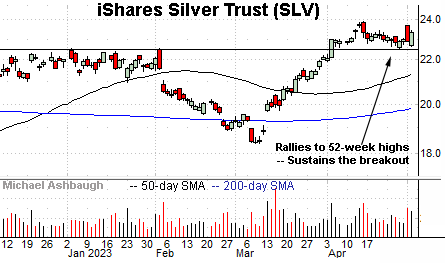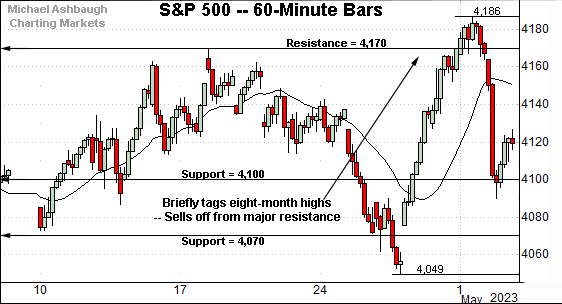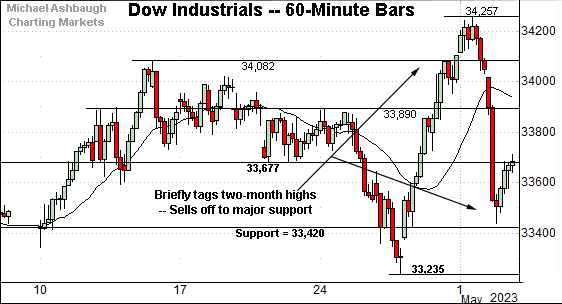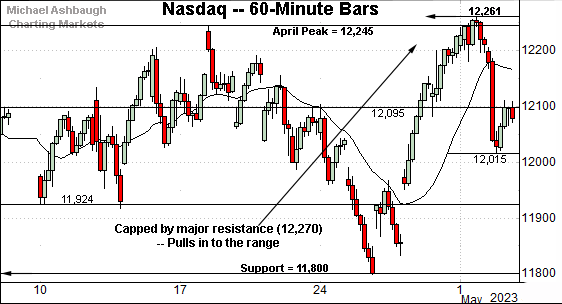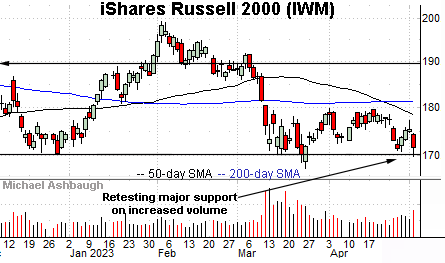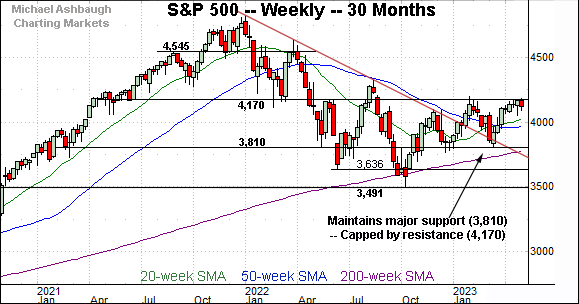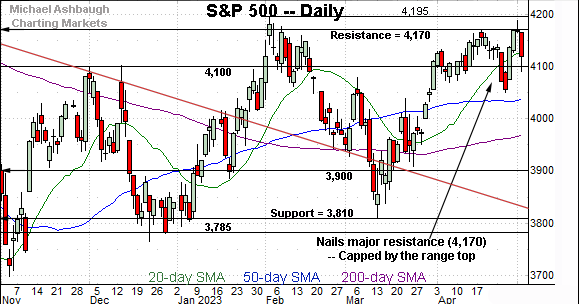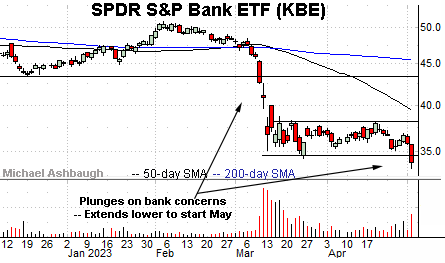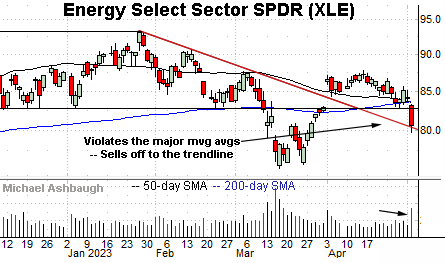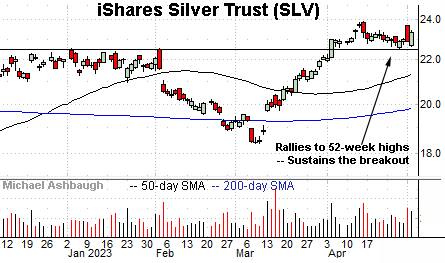Charting a market whipsaw, S&P 500 still capped by major resistance (4,170)
Focus: Energy and banking sectors pressured to start May, Silver sustains break to 52-week highs, KBE, XLE, SLV
Technically speaking, the major U.S. benchmarks have whipsawed to start May, and the worst six months seasonally — May through October.
The slight volatility spike punctuates the latest retest of two key technical levels — S&P 4,170 and Nasdaq 12,270 — areas that have drawn selling pressure at the turn of the month.
Editor’s Note: As always, updates can be directly accessed at https://chartingmarkets.substack.com.
Before detailing the U.S. markets’ wider view, the S&P 500’s hourly chart highlights the past four weeks.
As illustrated, the S&P 500 remains capped by major resistance (4,170).
In fact, the April peak (4,170.06) — established April 28 — almost precisely matched resistance. This area remains a headline technical hurdle, as detailed on the daily chart. (Also see the April 26 review.)
Similarly, the Dow Jones Industrial Average has started May with a false breakout.
The prevailing downturn places it firmly within the former range.
Tactically, consider that major support (33,420) — detailed previously — has underpinned the May pullback. The May low (33,436) has registered slightly above support.
Against this backdrop, the Nasdaq Composite has staged a less aggressive May downdraft.
Still, the index remains capped by major resistance (12,270) an area better illustrated on the daily chart below.
Widening the view to six months adds perspective.
On this wider view, the Nasdaq remains capped by major resistance (12,270), an area defined by the Sept. peak (12,270) and Feb. peak (12,269).
The May peak (12,261) has registered within nine points amid the latest failed retest.
Conversely, the Nasdaq has maintained the 50-day moving average, currently 11,817. Market bulls will point to a developing cup-and-handle defined by the March and April lows.
Looking elsewhere, the Dow Jones Industrial Average remains range-bound.
Recall the modest May whipsaw has been underpinned by major support (33,420) detailed previously. (Also see the hourly chart.)
More broadly, the index is traversing a prolonged range hinged to the steep October-through-November rally.
Meanwhile, the S&P 500 continues to press familiar overhead.
The specific area matches major resistance (4,170), a level extending back two years.
Against this backdrop, the April peak (4,170.06) and April close (4,169.48) matched resistance, an area that remains a sticking point. (Also see the April 26 review.)
The bigger picture
As detailed above, the major U.S. benchmarks have whipsawed to start May, and the worst six months seasonally — May through October.
In the process, the major benchmarks have once again balked at two major technical levels:
S&P 500 resistance at 4,170. The April peak (4,170.06) matched resistance.
Nasdaq resistance at 12,270. The early-May peak (12,261) has registered nearby.
For better or worse, these areas remain inflection points near the turn of the month. The pending selling pressure near resistance, or lack thereof, will likely add color.
Moving to the small-caps, the iShares Russell 2000 ETF (IWM) is pressing major support (170.30) amid increased volume.
The May downturn punctuates a flattish April rally attempt, capped by the 200-day moving average. As detailed repeatedly, eventual downside follow-through remains a prospect.
Similarly, the SPDR S&P MidCap 400 ETF (MDY) has pulled in to start May, pressured amid a volume spike.
Recall the MDY has hugged its 200-day moving average, not straying too far from it across nearly two months.
Slightly more broadly, see the developing head-and-shoulders top defined by the December, February and April peaks. (Also see the Russell 2000’s backdrop.)
Returning to the S&P 500, this next chart is a weekly view spanning 30 months. Each bar on the chart represents one week.
As illustrated, the S&P remains capped by major resistance (4,170) detailed repeatedly. (See the May 3, 2022 review — exactly one year ago — and more recently, the March 15, 2023 review.)
The April peak (4,170.06) matched resistance.
Conversely, recall the prevailing upturn originates from major support (3,810). The March low (3,809) registered nearby.
Narrowing to the S&P 500’s six-month view adds perspective.
Recall that loosely speaking, the range detailed on the weekly chart — spanning from 3,810 to 4,170 — has defined the 2023 price action. Just two closes have registered narrowly outside this range. (The Jan. 5 close (3,808) and the Feb. 2 close (4,179).)
Also recall this range precedes 2023. See the Dec. 20, 2022 review.
Against this backdrop, the S&P is acting relatively well near the range top. The late-April downdraft not only failed to follow-through, but was punctuated by a brief breakout attempt to start May.
Tactically, near-term support (4,070) is followed by the 50-day moving average, currently 4,038. A sustained posture atop the 50-day signals a bullish intermediate-term bias.
More broadly, the S&P 3,940-to-3,970 area remains a more important bull-bear fulcrum, matching two inflection points:
The 200-day moving average, currently 3,969.
The mid-point of the late-2022 range (3,942).
As always, it’s not just what the markets do, it’s how they do it. But generally speaking, the S&P 500’s bigger-picture bias remains bullish-leaning barring a violation of the S&P 3,970 area.
Watch List
Drilling down further, the SPDR S&P Bank ETF (KBE) remains a market headwind.
The group initially plunged seven weeks ago, pressured amid the initial round of regional banking concerns.
The subsequent rally attempt has been sluggish, and punctuated by downside follow-through to start May. Tactically, a swift reversal atop the breakout point (34.60) would mark an early step toward stabilization.
Meanwhile, the Energy Select Sector SPDR (XLE) has reversed course, pressured at least partly amid global-growth concerns.
Recall the group started April with a trendline breakout, gapping sharply atop the 50-day moving average.
Fast forward one month, and the group has staged an early-May downdraft, violating the 50- and 200-day moving averages amid a volume spike.
Tactically, the strong-volume downdraft likely wrecks the group’s recovery attempt. A swift reversal atop the breakdown point (82.70) and the 83.50 area would place the group back on a bullish-leaning track. (Also see the April 12 review.)
Concluding on a bright note, the iShares Silver Trust (SLV) is acting well technically.
The shares started the second quarter (April) with a breakout, rising to tag 52-week highs.
The subsequent sideways range signals muted selling pressure, likely positioning the shares to extend the uptrend. Tactically, a sustained posture atop the breakout point (22.50) signals a comfortably bullish bias. (The mid-April low (25.52) registered within two cents.)
Editor’s Note: The next review will be published Tuesday, May 9.

